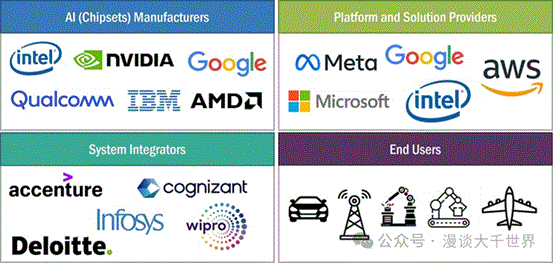market size forecasting
According to a Deloitte report, the global
AI chip market is expected to exceed $150 billion by 2025 and increase to $400
billion by 2027. Other institutions (such as Sohu related analysis) predict
that the market size will be about 91.96 billion US dollars in 2025, with an
average annual growth rate of 25.6% -33%. The difference may stem from
statistical caliber (such as whether edge device chips are included, etc.).

1. Technical roadmap and market positioning
• GPU
Representative manufacturers: Nvidia AMD、 Weiren Technology
Characteristics: Strong universality and
mature ecology.
• ASIC
Representative manufacturers: Google TPU,
Cambrian
Characteristics: High efficiency in
dedicated scenarios.
• Brain like chip
represents the manufacturer: IBM TrueNorth
Characteristics: Low power consumption, but
the ecosystem needs to be improved.
• Edge AI
Representative manufacturers: Horizon Robotics
Hailo
Features: low power consumption, high
energy efficiency ratio.
2. American companies
• NVIDIA (NVIDIA)
A100/H100 GPU: Based on Ampere/Hopper architecture,
supports large-scale AI training and inference, suitable for data centers and
supercomputing.
Jetson series (such as Jetson AGX Orin):
low-power AI chips for edge computing and robot scenarios.
Technical features: CUDA has ecological
advantages, strong compatibility, and is widely used in deep learning.
• AMD
Representative product: Instinct MI300
series: the first CPU+GPU heterogeneous chip designed specifically for
generative AI and high-performance computing optimization.
Positioning: Challenging Nvidia's dominant
position in the data center market.
• Intel (Intel)
Habana Gaudi/Gaudi2: ASIC chip for AI
training, benchmarked against Nvidia A100.
Movidius VPU: a visual processing chip
designed for edge devices, such as drones and security cameras.
• Google
represents the product: TPU v4: Dedicated ASIC chip, supporting Google Cloud AI services,
proficient in large-scale matrix operations.
• Cerebras Systems
represents the product: Wafer Scale Engine(WSE-3): A super large chip based on a whole
wafer, specializing in large model training, with computing power reaching
billions of times.
• Groq
represents the product: LPU(Language Processing Unit): Low latency
inference chip, specifically optimized for generative AI (such as LLM).
3. Chinese enterprises
Huawei (HiSilicon)
Representative product: Ascend 910/310:
Based on the da Vinci architecture, it supports full scene AI (cloud edge end)
and has a computing power of 256 TFLOPS.
• Cambricon
Representative product: Siyuan (MLU)
590:7nm process, supports kilocard cluster training, benchmarking against
Nvidia A100.
• Horizon Robotics
Representative product: Journey series
(such as J5): BPU architecture for autonomous driving, with a computing power
of 128 TOPS.
Biren Technology
Representative product: BR100 series: 7nm
general-purpose GPU, with computing power surpassing NVIDIA A100, focusing on
the data center market.
Iluvatar (Iluvatar)
Representative product: Big Island series:
Universal GPU, compatible with CUDA ecosystem, supports AI training and
graphics rendering.
Moore Threads
Representative product: MTT S series: a
domestically produced fully functional GPU that supports AI acceleration and
graphics rendering.
Mu Xi
Xi Si @N series: AI reasoning
Xi Yun @C-series: Large Model Training
Xi Cai @G Series: Graphics Rendering
• Suiyuan Technology
Yunsui T1x/T2x: Training
Yunsui i1x/i2x: Reasoning
Architecture: self-developed GCU-CARA
architecture
• Other updates: DeepSeek: It is reported that we are accelerating the layout of
self-developed AI chips and recruiting chip design talents.
4. Other emerging players
Tesla
Representative product: Dojo D1 chip:
supports autonomous driving video data training.
• Meta(Facebook)
Research and Development Direction: MTIA(Meta Training & Inference Accelerator): Optimize the recommendation system.
• Amazon
Representative products:
Inferentia/Trainium: Deploying self-developed chips
through AWS to reduce cloud service costs.